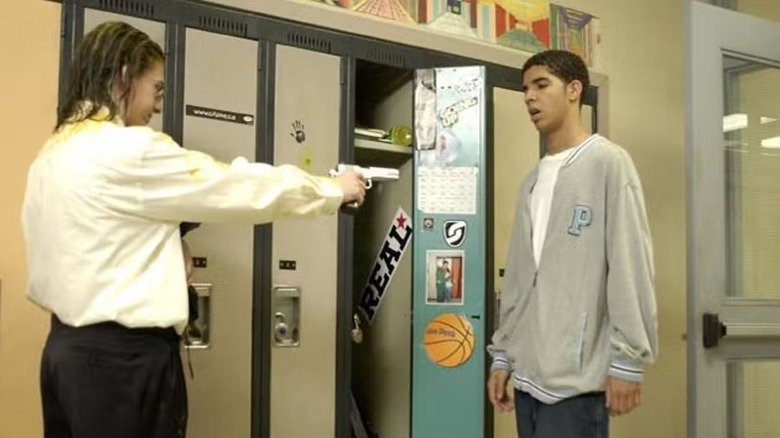The Story Behind The Times Stands Still Episode Of Degrassi: The Next Generation
The following article contains mentions of violence and domestic abuse.
"Degrassi: The Next Generation" rarely shies away from heavy subject matter, but even by the teen drama's standards, the Season 4 two-parter "Time Stands Still" is a strange ride. The episodes, which originally aired in 2004, depict the final fate of Rick Murray (Ephraim Ellis), the abusive boyfriend of Terri McGregor (Christina Schmidt). For a year or so, Rick has been an outcast because of his actions against Terri, and in "Time Stands Still," he's bullied until he reaches his breaking point and brings a gun in the school. When Rick goes after the people who he feels have slighted him, he accidentally loses his life when Sean Cameron (Daniel Clark) disarms him. Unfortunately, before this, he shoots Jimmy Brooks (Aubrey "Drake" Graham) in the back. As a result, Jimmy loses the use of his legs, and uses a wheelchair going forward.
Plenty of other things happen in the episodes, as well, but this shocking and sad main plot is likely a major reason why the climactic "Time Stands Still, Part 2" is considered the greatest "Degrassi: The Next Generation" episode ever (via IMDb), and the first part is holding the Number Four spot. Let's take a look at the story behind the award-winning (per IMDb) episode.
If you or someone you know is dealing with domestic abuse, you can call the National Domestic Violence Hotline at 1−800−799−7233. You can also find more information, resources, and support at their website.
The episode attempted to explore the causes behind the tragedy
As "Time Stands Still" co-writer and executive producer Aaron Martin told BuzzFeed News, the episode came at a time when school shootings did exist, but weren't quite as commonplace as they are today. He specifically mentioned the Columbine shooting as one that influenced the writers. The episode's intention was to depict the reasons that drive a teen to bring a gun to school, as well as condemn the way someone like Rick could just easily grab the gun from his father's drawer in a moment of anger and frustration.
"It was important to us [and Brendon Yorke, who wrote the two teleplays] that we present Rick as both a perpetrator, and a victim," Yorke explained. "Rick was violent, and the victim of violence. When pushed to the edge, Rick decided to get revenge in a terrible way."
He went on to explain the grand themes of "Time Stands Still," and how the episode attempted to look into the underlying questions behind a tragedy like this.
"We wanted to explore why. Why do teenagers do such terrible things? And how. How does a teen get his hands on a gun and bring it to school? How does no one see the warning signs? How does no one act on the warning signs? Or choose to turn a blind eye? How does someone as young and intelligent as Rick sink so deeply into his own anger, and hatred, that he decides to kill?"
Seeing as the two-part episode's shocking conclusion is one of the most memorable moments in "Degrassi: The Next Generation," it's probably fair to say that Martin and the rest of the team succeeded in their mission to deliver food for thought.

